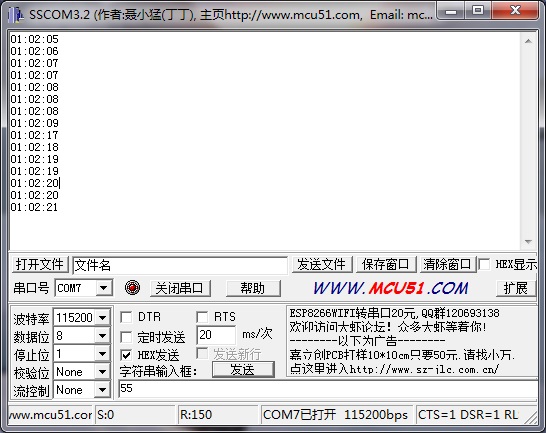RTC实时时钟的实验本来是非常简单的,但是这次版主花掉了不少的时间,而且是在认真的阅读了官方的数据手册才debug出来问题的所在。在一定程度上浪费了时间。
版主也本着分享与节省各位网友时间的前提下,将本次“失败”的编程经验帖出来。
本次实验的目的就是实现GD32F130的RTC外设;
实验的内容是利用GD32F130C-Start开发板上自带的32.768KHz的晶振来产生实时时钟所需要外置低速时钟源。
由于版主之前并没有接触过芯片的实时时钟配置(版主之前使用DS1302),因此,版主从网上下载了一些demo示例来移植的。虽然版主没有编写过RTC的程序,但是GD32简单的应用感觉工作也不会太难。
可是,问题恰恰就发生在网上下载的demo示例里。
版主的想法是,将RTC时钟初始化为1点2分3秒,但是移植后实验结果就是失败。无论如何设置时间均以失败告终。通过查询库函数文件,发现仅通过RTC_SetTime函数即可,但是结果却是不同。
开始怀疑是芯片的不同造成的,查询数据手册后发现,并无特殊配置要求,这里再将返回源代码进行debug发现,demo示例里居然将时间设置函数优先于RTC实时初始化之前了。
RTC实时时钟能没有开启,又如何能设置时间啊~~
轻信网上的demo示例损坏2天的时间,怒!!!

版主将调试成本的源代码分享如下:
/**
* @brief RTCconfig
* @param
* @retval
* @date 2015-04-01
* @note
*/
void RTCconfig(void)
{
ErrorStatus RTCstatus;
RTC_InitTypeDef RTC_InitStructure;
RTC_TimeTypeDef RTC_TimeStruct;
uint8_t TimeOut = 0xFF;
/* Enable the PWR clock */
RCC_APB1PeriphClockCmd(RCC_APB1Periph_PWR, ENABLE);
/* Allow access to RTC */
PWR_BackupAccessCmd(ENABLE);
/* Reset RTC Domain */
RCC_BackupResetCmd(ENABLE);
RCC_BackupResetCmd(DISABLE);
/* Enable the LSE OSC */
RCC_LSEConfig(RCC_LSE_ON);
/* Wait till LSE is ready */
while(RCC_GetFlagStatus(RCC_FLAG_LSERDY) == RESET)
{}
/* Select the RTC Clock Source */
RCC_RTCCLKConfig(RCC_RTCCLKSource_LSE);
RTC_WriteProtectionCmd(DISABLE);
/* Configure the RTC data register and RTC prescaler */
/* ck_spre(1Hz) = RTCCLK(LSI) /(AsynchPrediv + 1)*(SynchPrediv + 1)*/
RTC_InitStructure.RTC_AsynchPrediv = 0x7F;
RTC_InitStructure.RTC_SynchPrediv = 0xFF;
RTC_InitStructure.RTC_HourFormat = RTC_HourFormat_24;
RTC_Init(&RTC_InitStructure);
RCC_RTCCLKCmd(ENABLE);
RTC_WaitForSynchro();
/* Set the time to 00h 00mn 00s AM */
RTC_TimeStruct.RTC_H12 = RTC_H12_AM;
RTC_TimeStruct.RTC_Hours = 0x01;
RTC_TimeStruct.RTC_Minutes = 0x02;
RTC_TimeStruct.RTC_Seconds = 0x03;
do
{
RTCstatus = RTC_SetTime(RTC_Format_BCD, &RTC_TimeStruct);
TimeOut--;
}while((RTCstatus == ERROR) & (TimeOut > 0));
if(RTCstatus == ERROR)
{
while(1)
{
;
}
}
// RCC_RTCCLKCmd(ENABLE); /*!< 网上示例在此初始化 */
// RTC_WaitForSynchro();
}
/**
* @brief key check
* @param
* @retval
* @date 2015-03-28
* @note
*/
void KeyCheck(void)
{
bool KeyStatus;
KeyStatus = KeyScan(0);
switch(gKeyStatus)
{
case 0: /*!< 空闲状态 */
{
if(KeyStatus == true)
{
gKeyStatus = 1;
}
else
{
gKeyStatus = 0;
LedOff(0);
gSendCmdStatus = 0;
}
break;
}
case 1: /*!< 消抖状态 */
{
if(KeyStatus == true)
{
gKeyCnt = 5;
gKeyStatus = 2;
}
else
{
gKeyCnt = 0;
gKeyStatus = 0;
}
break;
}
case 2: /*!< 按下状态 */
{
if(KeyStatus == true)
{
if(gKeyCnt == 0)
{
//按键按下执行内容
LedOn(0);
gSendCmdStatus |= 0x0F;
}
else
{
gKeyStatus = 2;
}
}
else
{
gKeyCnt = 0;
gKeyStatus = 0;
}
break;
}
case 3: /*!< 确认按下 */
{
LedOn(0);
break;
}
default: gKeyStatus = 0;
}
}
/**
* @brief uart_int
* @param
* @retval
* @date 2015-03-29
* @note 发送使用DMA方式,接收使用中断
*/
void UartConfig(uint32_t band)
{
USART_InitTypeDef USART_InitStructure;
GPIO_InitTypeDef GPIO_InitStructure;
NVIC_InitTypeDef NVIC_InitStructure;
DMA_InitTypeDef DMA_InitStructure;
RCC_AHBPeriphClockCmd(RCC_AHBPeriph_GPIOA, ENABLE);
RCC_APB2PeriphClockCmd (RCC_APB2Periph_USART1, ENABLE);
RCC_AHBPeriphClockCmd(RCC_AHBPeriph_DMA1, ENABLE);
/* Connect pin to Periph */
GPIO_PinAFConfig(GPIOA, GPIO_PinSource9, GPIO_AF_1);
GPIO_PinAFConfig(GPIOA, GPIO_PinSource10, GPIO_AF_1);
/* Configure pins as AF pushpull */
GPIO_InitStructure.GPIO_Pin = GPIO_Pin_9 | GPIO_Pin_10;
GPIO_InitStructure.GPIO_Mode = GPIO_Mode_AF;
GPIO_InitStructure.GPIO_Speed = GPIO_Speed_50MHz;
GPIO_InitStructure.GPIO_OType = GPIO_OType_PP;
GPIO_InitStructure.GPIO_PuPd = GPIO_PuPd_NOPULL;
GPIO_Init(GPIOA, &GPIO_InitStructure);
USART_InitStructure.USART_BaudRate = band;
USART_InitStructure.USART_WordLength = USART_WordLength_8b;
USART_InitStructure.USART_StopBits = USART_StopBits_1;
USART_InitStructure.USART_Parity = USART_Parity_No;
USART_InitStructure.USART_HardwareFlowControl = USART_HardwareFlowControl_None;
USART_InitStructure.USART_Mode = USART_Mode_Rx | USART_Mode_Tx;
USART_Init(USART1, &USART_InitStructure);
/* NVIC configuration */
/* Enable the USARTx Interrupt */
NVIC_InitStructure.NVIC_IRQChannel = USART1_IRQn;
NVIC_InitStructure.NVIC_IRQChannelPriority = 0;
NVIC_InitStructure.NVIC_IRQChannelCmd = ENABLE;
NVIC_Init(&NVIC_InitStructure);
USART_ITConfig(USART1, USART_IT_RXNE, ENABLE);
DMA_InitStructure.DMA_PeripheralDataSize = DMA_PeripheralDataSize_Byte;
DMA_InitStructure.DMA_MemoryDataSize = DMA_MemoryDataSize_Byte;
DMA_InitStructure.DMA_PeripheralInc = DMA_PeripheralInc_Disable;
DMA_InitStructure.DMA_MemoryInc = DMA_MemoryInc_Enable;
DMA_InitStructure.DMA_Mode = DMA_Mode_Normal;
DMA_InitStructure.DMA_M2M = DMA_M2M_Disable;
DMA_DeInit(DMA1_Channel2);
DMA_InitStructure.DMA_PeripheralBaseAddr = USART1_TDR_ADDRESS;
DMA_InitStructure.DMA_BufferSize = (uint16_t)256;
DMA_InitStructure.DMA_MemoryBaseAddr = (uint32_t)(&gSendBuf[0]);
DMA_InitStructure.DMA_DIR = DMA_DIR_PeripheralDST;
DMA_InitStructure.DMA_Priority = DMA_Priority_VeryHigh;
DMA_Init(DMA1_Channel2, &DMA_InitStructure);
USART_DMACmd(USART1, USART_DMAReq_Tx, ENABLE);
USART_Cmd(USART1, ENABLE);
}
void main(void)
{
uint16_t i;
RTC_TimeTypeDef RTC_TimeStruct;
int8_t Str[] = "hello EEPW\r\n";
gKeyStatus = 0;
bspInit();
gCntLed[0] = 500;
gCntLed[1] = 500;
TxIndex = 0;
gSendCnt = 12;
for(i = 0; i < gSendCnt; i++)
{
gSendBuf[i] = Str[i];
}
UartConfig(115200);
if (SysTick_Config(48000)) //参数为系统时钟的向上溢出值,此配置为48000,即1ms中断一次
{
/* Capture error */
while (1);
}
RTCconfig();
while(1)
{
if(gCntLed[1] == 0)
{
LedToggle(1);
gCntLed[1] = gRcvBuf[0] * 4;
}
KeyCheck();
if(gSendCmdStatus > 0)
{
if(gSendCmdStatus < 0x10)
{
RTC_GetTime(RTC_Format_BCD, &RTC_TimeStruct);
gSendBuf[0] = RTC_TimeStruct.RTC_Hours / 10 + '0';
gSendBuf[1] = RTC_TimeStruct.RTC_Hours % 10 + '0';
gSendBuf[2] = ':';
gSendBuf[3] = RTC_TimeStruct.RTC_Minutes / 10 + '0';
gSendBuf[4] = RTC_TimeStruct.RTC_Minutes % 10 + '0';
gSendBuf[5] = ':';
gSendBuf[6] = RTC_TimeStruct.RTC_Seconds / 10 + '0';
gSendBuf[7] = RTC_TimeStruct.RTC_Seconds % 10 + '0';
gSendBuf[8] = '\r';
gSendBuf[9] = '\n';
DMA_Cmd(DMA1_Channel2, DISABLE);
DMA_SetCurrDataCounter(DMA1_Channel2, 10);
DMA_Cmd(DMA1_Channel2, ENABLE);
gSendCmdStatus |= 0xF0;
}
}
}
}
/**
* @brief SysTick_Handler的中断入口函数
* @param
* @retval
* @date 2014-11-23
* @note
*/
void SysTick_Handler(void)
{
if(gCntLed[0] > 0)
{
gCntLed[0]--;
}
else
{
gCntLed[0] = 0;
}
if(gCntLed[1] > 0)
{
gCntLed[1]--;
}
else
{
gCntLed[1] = 0;
}
if(gKeyCnt > 0)
{
gKeyCnt--;
}
else
{
gKeyCnt = 0;
}
}
/**
* @brief USART1_Handler的中断入口函数
* @param
* @retval
* @date 2015-03-29
* @note
*/
void USART1_IRQHandler(void)
{
if (USART_GetITStatus(USART1, USART_IT_RXNE) == SET)
{
gRcvBuf[0] = USART_ReceiveData(USART1);
}
}
工程如下:

 我要赚赏金
我要赚赏金

